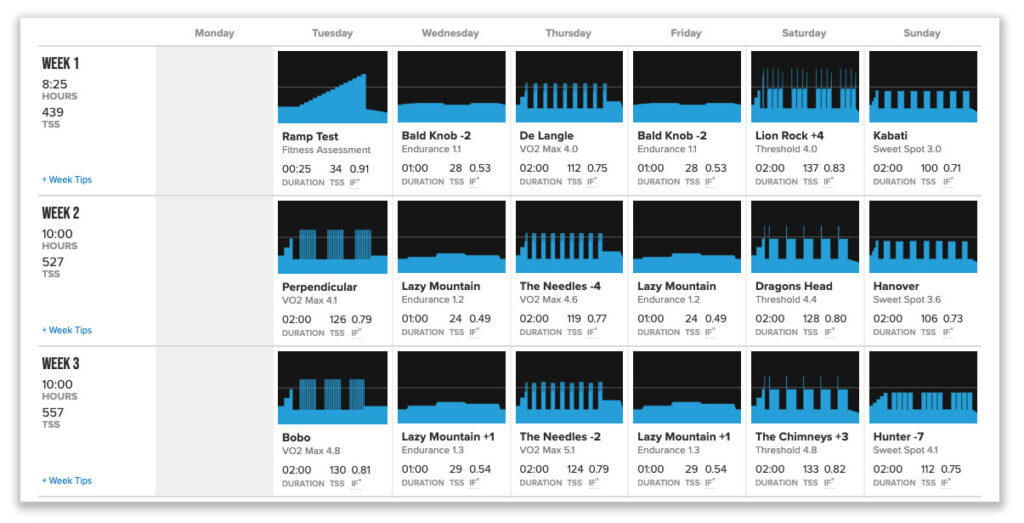Is a High-Volume Training Plan Right For You? Five Questions to Ask Yourself.

High-volume training plans are logistically and physically demanding, requiring a serious commitment of time and an exceptional capability to recover. For a small percentage of experienced athletes, high-volume training is a powerful way to develop race-winning fitness. Is high volume right for you?
Key Takeaways
- Following a high-volume plan might sound like a badge of honor, but it’s not a sustainable way to build fitness for most athletes.
- Don’t consider a high-volume plan unless you have extensive structured training experience.
- High-volume plans require a significant investment of time and an exceptional capacity to recover.
- Athletes who plateau on mid-volume plans should address other limiters before increasing their volume.
- If you plan to add additional rides or workouts, low- and mid-volume plans are usually a better option.
Endurance athletes love a challenge, and we celebrate our ability to endure as a badge of honor. Unfortunately, many of us apply this mentality when choosing a training plan. We reflexively gravitate towards higher volumes and harder workouts, without questioning whether we’ve chosen the most sustainable and productive path.
In reality, training plans are just a means to an end, and you should choose the one that best matches your lifestyle and goals. Is this a high-volume plan? For most of us, the answer is no, but here are five questions to ask yourself to find out.
1. Are You Experienced With Structured Training?
Structured training is designed around a sustainable, long-term approach. This applies within a season as well as over multiple years, as your body grows incrementally stronger and more capable of handling stress and recovery.
This is why high-volume training plans simply aren’t recommended for new athletes. For the workload of these plans to be productive, you need a resilient foundation built over several years of previous experience with structured interval training. Otherwise, the accumulation of so much training stress can lead to fatigue, non-functional overreaching, and a possible decline in fitness.
And that’s just the physical side of things. Experience also teaches you how to integrate the considerable fueling, recovery, and time demands of getting faster into your daily life. If you’re new to structured training, stay consistent with a low- or mid-volume plan before you take on the much more challenging task of high-volume.
2. Do You Have the Available Time?
High-volume training is a major commitment. Depending on discipline and phase, it usually averages at least 8 hours of structured training each week, with as many as 10 weekly hours on the bike required for some plans. That might not sound like a lot, but if you consider how these hours are accumulated, the commitment of a training plan becomes more apparent.
Most cyclists who ride 8 or more weekly hours do short rides during the week and longer rides on the weekend. But in a high-volume training plan, structured training time is distributed throughout the week, with tough 90–120 minute workouts on both weekdays and weekends. High volume plans also differ from long, unstructured training weeks in their requirement for consistency. While many of us can occasionally find time for a big training week, high-volume training plans demand this every week for several months or more.
In the end, consistency is key, and the most effective training plan is the one you can successfully complete. Before starting a high-volume plan, ask yourself whether your schedule reliably allows for such a significant commitment of time.

3. Are You Capable of Recovering Consistently?
Recovery makes you faster. Adding more volume and training stress only makes you fitter if your body is capable of productively handling it. If not, the cumulative effect of too much training stress will slow you down, and if unchecked, can eventually lead to overtraining.
For this reason, one of the most important requirements for high-volume training is a robust ability to recover. Some athletes can simply bounce back more quickly than others; this capability grows with experience and is also influenced by genetics and age. But recovery is more than physiology, as it requires time, resources, and commitment.
To recover successfully in a high-volume plan, rest days should actually be restful, free of physically demanding tasks and external stress. Your diet needs to fuel your workouts and replenish you afterward with the nutrients your body needs to make repairs. And you need to consistently and reliably get lots of good quality sleep. These factors are major limiters for many athletes. Before you attempt a high-volume plan, honestly ask yourself whether you are physically and logistically capable of recovering, week after week.
4. Have You Stopped Improving at Lower Volumes?
The concept of minimum effective dose dictates that it’s healthiest to employ the smallest amount of training stress needed to achieve your desired result. In other words, just because you can train more, doesn’t always mean you should.
For the majority of athletes, the dose of training in a low- or mid-volume plan is enough to see consistent progress. Eventually, however, you may find yourself reaching a fitness plateau. When this happens, your body is at homeostasis— a point of equilibrium in which there is no longer enough input to sustain further improvement.
To break through a plateau, something in your training needs to change, but that doesn’t automatically mean the answer is more volume. It’s often external factors like nutrition, consistency, recovery, and outside stress holding you back, and you can address these limiters without adding any additional training stress. You may eventually find the increased stimulus of a high-volume plan is, in fact, what you need. But always default to the minimum effective dose, and only consider high volume if you still don’t see progress after improving other variables first.
Adaptive Training
Get the right workout, every time with training that adapts to you.
Check Out TrainerRoad5. Do You Plan to Add Additional Workouts or Unstructured Rides?
All TrainerRoad training plans are progressive in design. Each week builds on the last, systematically targeting energy systems and skills so you arrive at your goal event ready to succeed.
This is why consistency is so important, and why athletes planning to add additional rides may be better served by low- or mid-volume plans. On these plans, it’s comparatively easy to complete all your scheduled workouts with time and energy left over to ride with your friends. High volume plans are different— for most athletes, the copious training stress doesn’t leave much room for error. Add unplanned rides, and you may find yourself too fatigued to complete your upcoming workouts as planned. This isn’t a big deal now and then, but over the long term, skipped workouts and additional fatigue can add up and hold you back.
As a general rule, it’s preferable to add workouts to a low- or mid-volume training plan than to skip workouts on a high-volume plan. So even if you can otherwise handle a high training volume, you may want to consider a more flexible option if it better fits your riding style.
In Conclusion
High-volume training plans aren’t for everyone. Even if you are used to riding an equivalent number of unstructured hours each week, you’ll likely find such a high volume of structured training to be a challenge. These plans require extensive experience, a major commitment of time, and an exceptional ability to recover. They are best reserved for athletes who have fine-tuned their nutrition and recovery strategies, yet no longer see improvements on mid-volume plans. They’re also best for athletes who don’t plan to add much additional riding, as they lack the flexibility of low- and mid-volume training.
For a small percentage of experienced cyclists, high-volume plans are the ideal path to competitive fitness. But the best plan is the one that sustainably prepares you to reach your goals, and for most of us low- or mid-volume plans are simply a better fit.